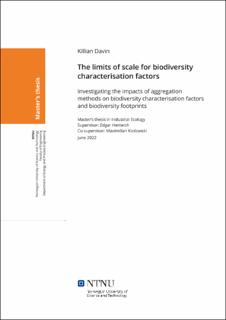| dc.description.abstract | The Anthropocene is increasingly affecting all aspects of the world today and it has had and continuous to have catastrophic impacts on biodiversity. Natural ecosystems have suffered a decline of 47% relative to their earliest predicted baseline (IPBES, 2019). Agriculture is the largest contributor to ecosystem impacts with agricultural land use, land transformations and blue water consumption for irrigation the primary drivers of global extinctions today (IPBES, 2019; IUCN, 2021). Biodiversity impact studies where environmentally-extended multi-regional input-output (MRIO) modelling is merged with life cycle impact assessment (LCIA) methodology have continually pointed to the limitations of the regional scale of input-output tables for capturing the heterogeneous and inherently localised impacts of biodiversity (Moran et al., 2016; Verones et al., 2017). The availability of spatially explicit LCIA databases for application in life cycle analysis are hampered by the need for aggregating native scale characterisation factors (CFs) to the national/continental scale which introduces aggregation errors.
In the absence of spatial datasets for elementary stressor flows, CFs are aggregated to the national level via proxy of ecoregion land shares for land use and total blue water consumption at the watershed level for water stress. Koslowski et al. (2020) suggested that the largest source of uncertainty in biodiversity footprint results at the national level likely originate from the aggregated CFs and not the MRIO models themselves despite recent focus on improving the national resolution of MRIO tables (Bjelle et al., 2021; Cabernard & Pfister, 2021).
Here, we apply a global agricultural production model, MapSPAM (Yu et al., 2020) with the LCIA database, LC-IMPACT (Verones et al., 2020), to create crop-specific national CFs for agriculture and for the impact pathways of land use and blue water consumption. Our approach uses elementary stressor data available from MapSPAM for weighting of the native scale CFs to the national level, diverging from the approach used in LC-IMPACT for national aggregation. We investigated if the differing aggregation approaches and the increased spatial explicitness of the constructed CFs deviate substantially from those in LC-IMPACT and what the resulting consequences for national production and consumption-based biodiversity footprints are.
The results revealed an increase in global production-based biodiversity impacts of 38% and 17.5% for land use and blue water consumption respectively. Large variations in CFs between crops and within countries demonstrate the pressing need for regionalization of MRIO models if the heterogeneity of biodiversity impacts are to be fully realized. The results clarified that broad cropland categories of land use, the absence of category distinctions for wetland multipliers and current upward aggregation techniques for native scale CFs are a poor proxy for describing country level ecosystem damage from agricultural production. The disparity in resulting national CF factors depending on the aggregation methodology used is evidence that modelling of national level CFs in LCIA databases must be reassessed if biodiversity footprint analysis with MRIO tables are to be improved at the national level. | |
